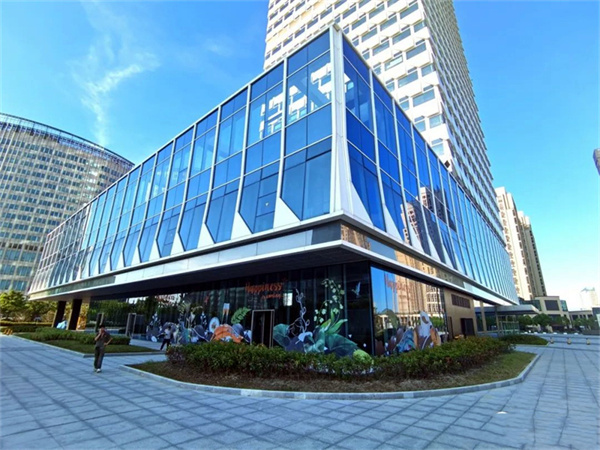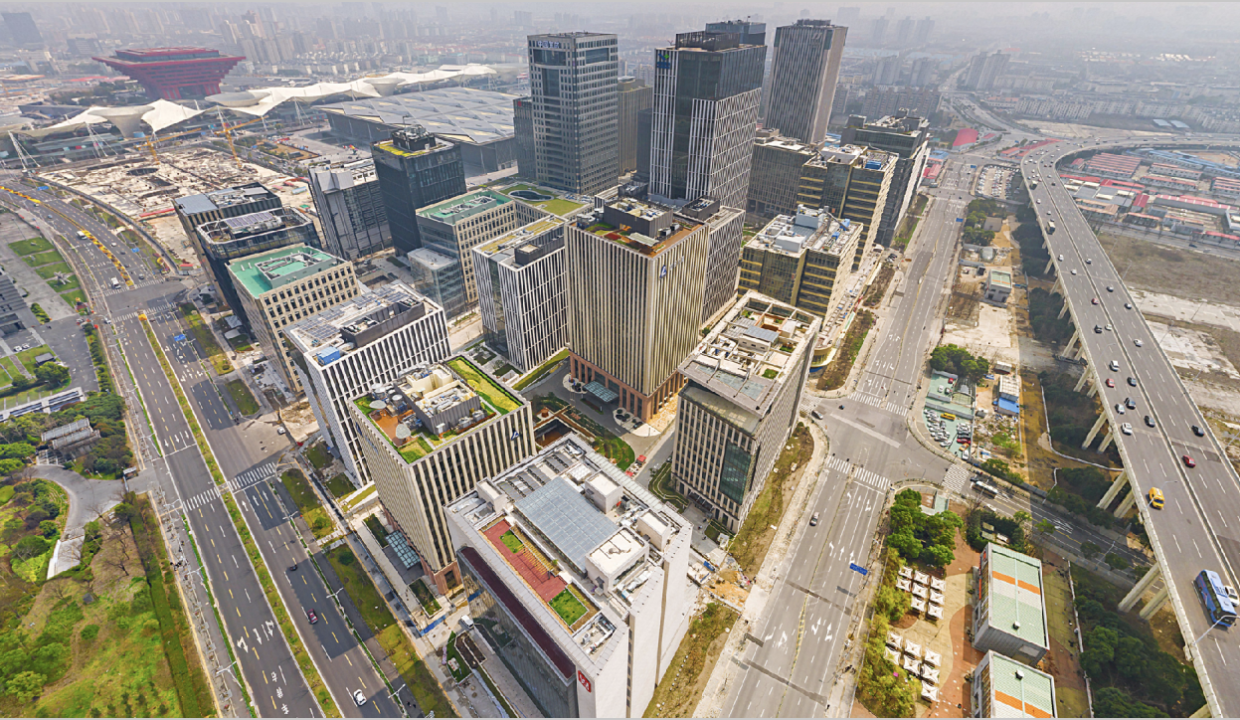The office buildings in Shanghai have developed from scratch in just over 30 years. During these 30 years, it can be said that they have gone through ups and downs, and finally formed a mature market pattern. But with the resurgence of the global economy and the rapid development of the Shanghai economy. Shanghai office buildings have entered a new era.
Before the mid-1980s, the concept of commercial office buildings in Shanghai was basically zero. At that time, some large companies could only rent hotel suites if they needed to set up offices in Shanghai. Until 1985, the first foreign-related office building in Shanghai, the Friendship Building located on the Bund, was completed, followed by the construction of the Shanghai Mall in 1990. However, the real wave of office market in Shanghai began with Deng Xiaoping’s southern tour speech in 1992.
In 1993, Shanghai began to release office land on a large scale. According to convention, the construction period of office buildings is generally 3 years, which means that office buildings that started construction in 1993 began to be listed in 1996. However, it was precisely this large-scale listing that led to a comprehensive oversupply of the Shanghai office market from 1997 to 1999, with a peak period of 1 million square meters in 1997. The oversupply in the market and the impact of the Asian financial crisis directly led to a continuous decline in office rental prices, from an average price of $0.8 per square meter per day in 1997 to $0.4 per square meter per day in 1998, and further to $0.2 per square meter per day in 1999.
The economy began to recover in 2000. In terms of office buildings in Shanghai, there was a period of adjustment from 2000 to 2001, during which numerous unfinished projects were revived, and the vacancy rate of office buildings gradually decreased. Another spring arrived in Shanghai’s office buildings in 2002, with a mild rebound starting from the * th quarter. During this period, China’s accession to the WTO had a positive impact on some companies, and on the other hand, after the 9/11 attacks in the United States, some companies that had postponed their decisions began to reconsider their expansion needs for office buildings at the end of last year. The vacancy rate in the city has dropped to 11.9%, with rent reaching $0.62 per square meter per day. The annual absorption has reached 404795 square meters, and the total absorption has slightly increased by 2.4% compared to 2001. In 2003, the lack of new supply on one hand limited the absorption of Grade A office buildings in Puxi, and on the other hand, the vacancy rate level showed a downward trend as a result. Therefore, the decrease in newly added area in 2003 led to a historically low absorption level of approximately 272000 square meters, a decrease of 38.2% compared to 2002. Due to limited new supply and suppressed demand under tight market conditions, the average rent of Grade A office buildings in Shanghai has increased by 5.6% compared to 2002.
In the third quarter of 2004, the Shanghai office market experienced rapid new supply, coupled with sustained demand for office space from multinational corporations, resulting in a huge overall absorption of 508300 square meters. The vacancy rate in Puxi decreased to 5%, and rent increased to an average of 0.73 US dollars per square meter per day.
From 2004 to the end of 2007 was a period of rapid development for office buildings in Shanghai. The favorable business environment and rapidly developing Chinese economy in Shanghai have attracted numerous organizations to invest in the city. Some expanding companies are finding it difficult to find suitable office spaces in the existing office market to meet the office demands brought about by the constantly growing staff size. Due to the strong demand for high-quality office buildings, the situation of pre leasing office buildings has become increasingly severe. These companies must make plans in advance to ensure the required office space.
The vacancy rate of Grade A office buildings is also rapidly declining, mainly due to the continuous expansion of demand and the decrease in market supply. As of the end of 2007, the vacancy rate of Grade A office buildings in the city was 1.51%; Compared to 5.28% in 2006, it decreased by 3.77 percentage points. From a regional perspective, the vacancy rate in Lujiazui is relatively low, at 0.11%.
Due to increasingly strong expectations for mainland finance, the number of financial institutions in Lujiazui continues to grow, making it a popular area for the entire market throughout the year. Due to the continuously decreasing vacancy rate of office buildings in Shanghai and the lack of relief in market demand, the average rent has continued to rise, reaching 1.23 US dollars per square meter per day (RMB 9.04 per square meter per day).
The development from 2008 to the third quarter continued the rapid growth of the previous two years. The demand remains high, but the launch of the Global Financial Center and Future Asset Building in the third quarter has led to an increase in vacancy rates. With the increase in market supply, it naturally led to a decline in prices. As of the end of the third quarter of 2008, the quoted price for Grade A office buildings was 8.69 yuan/square meter/day. Compared to the same period in the previous year, it decreased by 3.87%.
With the impact of the global financial crisis on the Shanghai financial market, it directly led to the turning point in the third quarter of 2008. In addition, the increase in supply of Jia-A office buildings in Shanghai and the decrease in demand resulted in a significant decline in vacancy rates and absorption in the fourth quarter.
After years of development, the traditional office building market in Shanghai is mainly distributed in six major areas at the micro level: Nanjing West Road, Huaihai Middle Road, Xiaolujiazui, Hongqiao, Xujiahui, and People’s Square. Once upon a time, these six major regions gathered the vast majority of office properties in Shanghai, currently accounting for about 90% of the city’s supply.
effected by the destructive force of the 2008 economic crisis, the vacancy rate of Shanghai’s office buildings reached its peak in 2009, with a vacancy rate of approximately 17% for the entire Jia A office building in Shanghai. The government and developers did not promote the construction of new commercial land.
With the implementation of a series of rescue strategies by the government, the Chinese economy has returned to a thriving track from 2010 to 2014. At the same time, Shanghai, as a financial center city, has launched a P2P led financial innovation model in the financial field since 2013, which has caused a large demand for Jia A office buildings. Due to the economic blow in 2008 and 2009, many developers did not acquire new commercial and office land in these two years. Therefore, by 2013, the new supply had sharply declined, and the demand was far greater than the supply. Although a certain number of Jia A office buildings were launched in the market in 2014, they were mainly concentrated on the central and outer ring roads centered around Hongqiao Business District. The market demand for Jia A office products in the city center was relatively strong. The average rent for a building reaches 12 yuan per square meter per day, making it difficult to find a single room, The vacancy rate of office building A in the center of Shanghai is as low as 2.3%.
Seeing the strong demand for Jia A office buildings in the entire market in 2013, various districts gradually launched their own 2030 plans, including the North Bund, Xuhui Binjiang, World Expo, Qiantan Houtan, Hongqiao Business District Expansion Area, and Qishen Road Gudai Road area. Large areas of commercial and office land were planned to be put into the market. From 2015 to 2018, more than one million square meters of office buildings were put into the market every year. Fortunately, at the same time, the country’s mass entrepreneurship and innovation have continuously increased the demand for office buildings. However, compared to the supply of millions of units, the vacancy rate of office buildings has steadily increased from 2015 to 2017, reaching 8.5% by 2017. At this time, the rent for office buildings in the city center A was basically 10 yuan/square meter/day.
The supply of office buildings in 2018 has passed, and the supply has decreased to over one million. But at this time, the wave of entrepreneurship is coming to an end, and the demand is decreasing instead of increasing. Fortunately, this year, the demand for co working second landlords has once again supported the demand, but the upward trend of vacancy rate has not been achieved, and the vacancy rate has already reached 16%.
In 2019, continuing the downward trend of 2018 at the beginning of the year, and at the same time, the trade war with the United States broke out, with a supply of nearly 990000 cubic meters throughout the year and a demand area of only 400000 to 500000 cubic meters. The overall vacancy rate has reached 22.3%, and at this time, the rent for office building A in the city center is basically around 9 yuan/square meter/day.
However, there is no need to worry. Overall, although the vacancy rate remained the same in 2019 compared to 2018, Shanghai far exceeded 2008 in terms of the distribution scale of office buildings and the total number of enterprises. The six core CBDs in 2008 (Nanjing West Road, Huaihai Middle Road, Xiaolujiazui, Hongqiao, Xujiahui, and People’s Square) have now expanded to include Wujiaochang, North Bund, Night City, Zhenru, Changfeng Business District, Hongqiao Business District, Caohejing, Xuhui Binjiang, Qiantan World Expo, Zhangjiang, Century Park, etc. It is normal to encounter some bumps and obstacles on the road to growth. When the difficulties pass, we will welcome glory.




